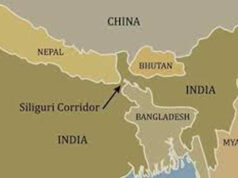Tilak Sindoor Shiv Temple : The one of its kind in the world
The fact that the present time of the year is one of the most auspicious in terms of paying our reverence to Lord Shiva

By Colonel Satish Singh Lalotra
The month of July often associated with complete onset of SW monsoon in the entire sub-continent of ours , brings in its wake a plethora of events that are closely intertwined with the religious beliefs of countless millions of the majority faith ( Hindu). The so called ‘Trinity of Gods’ (Brahma, Vishnu & Mahesh) assiduously worshipped by the faithful lot of India represent the creator, saviour and the destroyer of the world. Out of this Trinity of Gods it is the destroyer (LordShiva) that attracts the max of attention, worshipping and consequent efforts by his millions of believers to assimilate and emulate his teachings and beliefs in the mortal world of ours.
As the legend goes in the Hindu mythology of myriad kinds, the month of ‘Sawan’ is derived from the ‘Shravan Nakshtra’( constellation) which is a powerful story of sacrifice and divine intervention. During the churning of the ocean (sumdra -manthan) by the various ‘Devas’( Gods) to get the so called ‘Amrit’, a deadly poison called as ‘Halahal’ emerged threatening all life forms on this earth of ours. Since the world was to be saved Lord Shiva drank all the poison himself and thus turned blue due to the poisoning effect on his body. Lord Vishnu then appeared on the scene and did his ‘Jal Abhishekh’ to ensure his prosperity and longevity in life. All this occurred in the month of Savanand hence all importance of this month of monsoon’s connection with the lord of destroyer (Shiva).May be it is the ‘rebel within me’ quality of Lord Shiva that announces his personification in we human beings as we go about worshipping him in our daily chores, battling the vicissitudes of our existence and survival on this terra firma.
July is also the month when all over the Indian sub-continent the great pilgrimages to Amarnath as also to the mother of all yatras i.e.KaliashMansarovar kickoff in all their religious fervor. Can anybody forget the irresistible ‘Kanwariyas’ who undertake the gruellingannual ‘Kanward yatra’ by collecting the holy water of Ganges from places like Haridwar, Gomukh, Gangotri etc only to offer at famous Shiv temples of Aughadnath at Meerut and Kashi Vishwanath temple of Lord Shiva traversing thousands of kilometers of highways and roads braving hazards to their lives and limbs? Without a care in the world they trudge on to their holy destinations with many of them losing their precious lives enroute. Amidst all these celebrations which have Lord Shiva as center of attraction, there are still many myths which are associated with this Hindu God that lie buried deep into the hinterland of India.
One such holy abode of Lord Shiva that has unique setting in terms of landscape, its remoteness, the way of its formation and the only known ritual of bathing the Shivling in Vermillion ( Sindoor) in addition to holy water of Ganges, milk , honey or sandal wood paste as known and practiced in the world is located at a nondescript place called as ‘Khatama’ ; a forest village about nine kms from village Jamani in tehsil Itarsi of Madhya Pradesh. The cave like temple is built by cutting a rock at a height of about one thousand two hundred and thirty feet (1230 ft) which has a flight of about 70 odd stairs / steps leading to its precincts. The plan of this so called cave –temple is simple in its architecture which consists of a ‘Mandapa’ based on four pillars with a square ‘Garbha-griha’ in the center that enshrines a ‘Shivlinga’ and a Nandi idol in its front. An ambulatory passageway has been carved by cutting the rock on all four sides. This state protected monument can be ascribed to the 10-11th century A.D.
I have had the opportunity and time to explore this unique pre-historic cave temple cum monument way back in 2011 while still in service and posted at Itarsi(MP) at one of the country’s premium proof firing establishment, going by the name of ‘Central proof firing establishment –CPE Itarsi.’Located at a distance of about 18 kms from district headquarters of Hoshangabad in the midst of Satpura hills , this ancient cave temple cum monument dating back to 10 th century A.D was known to the majority of local employees of CPE Itarsi who used to make a beeline during the auspicious month of Savan ( Shravan) as also on Mahashivratri where a massive fair used to take place in the month of Feb/ March every year drawing all and sundry including celebrities from far and wide. On knowing its pre-historic fame dating back to 10th century A.D , I too along with the then Deputy commandant of CPE Itarsi went to this holy place to check out its fame to glorious historical past as also to pay our obeisance at the cave temple.
Though there are dime a dozen Shiv temples dotted all over the sub-continent , but then there are very few which are nestled deep into the forests of Satpura jungles , cut out of rock caves & patronized by the tribal chiefs and Rajas of Satpura –Vindhya chal. This cave temple was earlier under the jurisdiction of the royal family of ‘Makrai’ going by the title of ‘Shah of Makrai’. These Makrai Rajas were basically of ‘Gond’ tribe and used to practice the animistic religion that had its basis of worship in natural objects like sun, moon, rivers and such like natural resources.
Even today the vast swathes of Satpura Mountains are abode to a plethora of tribes like the Gonds, Korkus, Baiga and Bhils which form a major chunk of tribal concentration in India. It will be quite interesting to know for the readers of this article that Lord Shiva is one of the only Hindu Gods that is worshipped by the tribal population of Satpura mountains known by the name of ‘Bada Dev’ or big God. May be the very demeanor of Lord Shiva including the serpent woven around the neck and sitting cross legged on the hide of a leopard made the tribal people associate him with their animistic Gods. Whatever may be the alluring features of this Hindu pantheon to make the tribal people gravitate towards his very being , the entire complex of this cave mountain temple is still looked after the ‘Adivasi seva samiti’ or tribal welfare organization of the area which is quite unusual for the upkeep of a Hindu temple. Thus cementing the eternal bond between Lord Shiva and the dwellers of these mountains of Satpura.
It is said that for the annual grand coronation of Lord Shiva on the occasion of Mahashivrartri, the ‘Makrai royal house’ used to be always the trend setter and lead the way in coronation efforts. As for the annual fair it started in the year 1925 with changed responsibilities wherein the local revenue officials of village Jamani took on the task, that was later on taken over in the year 1970 by the ‘kesla’ village panchayat. As per late Kalikanand one of the famed worshippers cum Yogi, this temple has its eminence equal to if no more than the world famous ‘Omkareshwar’ temple in Madhya Pradesh. The extraordinary facet of this temple is that the ‘Jalhari’ or the small natural pit of water into which the famous Shivling has been bathed regularly is quadrilateral in shape unlike the normal triangular ones seen all over the places in the country.
Legend has it that when the demon king ‘Bhasmasur’ beseeched Lord Shiva to grant him few wishes being his ardent follower, the Lord granted him the wish that whosoever he keeps his hand on would be burnt to death. Ironically the demon king tried to put his hand on the lord’s head itself that prompted the God to dash towards these Satpura Mountains to seek refuge from the demon’s rashness. It is said that the lord spent few days incognito in these caves from where he then eventually went underground to ‘Pachmarhi’( famous hill station) through a tunnel where he established another place of reverence called as ‘Jatashankar’. It is the same place where the demon king was finally slayed by Lord Shiva for his misdemeanours. It is said that this underground tunnel from Tilak sindoor temple till Pachmarhi still exists, a distance of about 140 kms though nobody has confirmed this fact in absolute terms.
Another interesting legend that still is going strong over here is lend credence by the sayings of the head priest of this temple Mr Ramnath Nagale, wherein he asserts that the place has abundance of stones from which vermillion( sindoor) comes out on its own and hence the name of the temple. This sounds rather unnatural and out of context. Be that as it may, the fact of the matter is that this Shiv temple in the central India has etched its name in the annals of history seekers as well as aficionados of ancientarchitecture governing construction of such marvelous temples that lie obscured from general public’s eyes. Moreover it has singular credit to its fame that this Hindu lord is equally worshipped by the vast tribal population of Madhya Pradesh cutting across tribal affinities who otherwise are very ‘Hidebound’ in their personal matters. The fact that the present time of the year is one of the most auspicious in terms of paying our reverence to Lord Shiva, I in my wisdom thought to pen down something regarding this head of Hindu pantheon which I am convinced will be liked by the readers of this write up of mine.
( The writer is a regular scribe of RK and can be reached at: slalotra4729@gmail.com)




